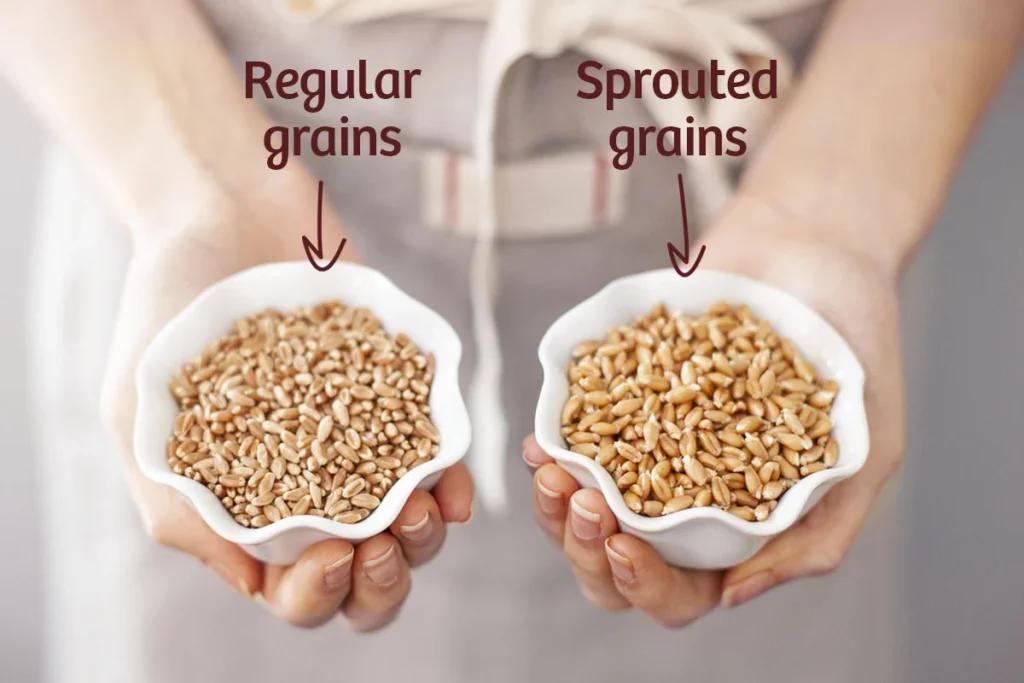Introduction
Whole grains are fundamental to global diets, valued for their fiber, complex carbohydrates, vitamins, and minerals. However, their nutritional impact can be significantly altered by processing techniques, one of which is sprouting. Sprouting—also known as germination—is a natural process that transforms dormant seeds into biologically active seedlings. During this transformation, a cascade of enzymatic reactions enhances the bioavailability of nutrients, reduces antinutritional compounds, and improves digestibility.
Therefore, understanding the biochemical shifts that occur during sprouting is crucial for evidence-based nutritional guidance. This article scientifically compares sprouted and unsprouted grains in terms of nutrient density, health effects, and practical dietary applications, highlighting their role in optimizing digestive health, glycemic control, and micronutrient absorption.
What Are Sprouted Grains?
Sprouted grains are whole cereal grains that have been soaked in water until they begin to germinate. This triggers the activation of endogenous enzymes such as amylases, proteases, and phytases, which begin the breakdown of starches, proteins, and antinutrients like phytic acid, respectively (Benítez et al., 2013). The sprouting phase typically lasts 24 to 72 hours depending on the grain type and environmental conditions.
Key Changes During Sprouting
-
Enzyme Activation
Amylases break down starch into simpler sugars, proteases enhance protein digestibility, and phytases reduce phytic acid (Benítez et al., 2013). -
Reduction in Antinutrients
Sprouting decreases phytic acid content by 30–50%, facilitating better absorption of zinc, iron, magnesium, and calcium (Liang et al., 2008). -
Increase in Bioactive Compounds
Levels of antioxidants (such as phenolic acids and flavonoids) increase by 20–30% (Paucar-Menacho et al., 2017), while GABA (gamma-aminobutyric acid) content increases, supporting neurological function and stress modulation (Oh et al., 2005).
Nutritional Comparison: Sprouted vs. Unsprouted Grains
| Nutrient | Sprouted Grains | Unsprouted Grains | Difference |
|---|---|---|---|
| Protein Digestibility | Increased (due to protease activity) | Lower (intact proteins) | +15–20% (Koehler et al., 2007) |
| Fiber | Higher (soluble fiber increases) | Standard whole grain content | +10–15% (Hung et al., 2012) |
| Vitamin C | Present (newly synthesized) | Absent | New synthesis (Wu et al., 2013) |
| B Vitamins (B2, B6, Folate) | Increased | Baseline levels | +20–50% (Plaza et al., 2003) |
| Glycemic Index (GI) | Lower | Higher | Reduced by 10–20% (Hsu et al., 2008) |
Health Benefits of Sprouted Grains
1. Improved Digestibility and Reduced Gut Irritants
-
Lower FODMAP content makes sprouted grains suitable for individuals with irritable bowel syndrome (Varney et al., 2017).
-
Reduced gluten content may benefit individuals with mild gluten sensitivity, although not safe for celiac disease(Rosell et al., 2015).
2. Enhanced Mineral Absorption
-
The reduction of phytic acid leads to a 50% increase in iron absorption from sprouted grains compared to unsprouted (Lestienne et al., 2005).
3. Better Blood Sugar Control
-
A lower glycemic index helps moderate postprandial glucose spikes, making sprouted grains favorable for diabetes management (Kendall et al., 2011).
-
Increased resistant starch content supports gut health via prebiotic action (Topping et al., 2003).
4. Higher Antioxidant Activity
-
Sprouted brown rice demonstrates twice the antioxidant capacity compared to its unsprouted counterpart (Zhang et al., 2010).
Potential Downsides of Sprouted Grains
-
Shorter shelf-life due to increased moisture and enzyme activity (risk of mold).
-
May have a mildly bitter taste, particularly if not cooked or processed properly.
-
Not safe for celiac patients, as sprouting reduces but does not eliminate gluten.
Practical Recommendations
✔ Athletes & active individuals: Improved protein and micronutrient utilization
✔ Diabetics: Lower glycemic index aids in blood glucose control
✔ Mineral deficiencies: Enhanced absorption of iron and zinc
❌ Avoid if you have celiac disease or mold sensitivities
Conclusion
Sprouting significantly enhances the nutritional profile of grains, offering superior protein digestibility, increased vitamins and antioxidants, reduced antinutrients, and better glycemic control. While not essential for every individual, sprouted grains are a functional and nutrient-dense food choice for those aiming to optimize digestive health, metabolic balance, and mineral uptake.



